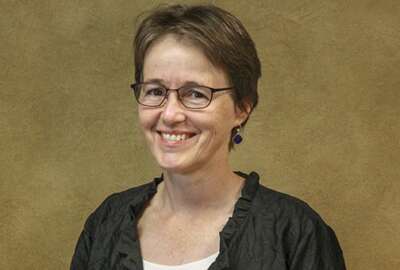How the US Geological Survey aids the search for critical minerals
The U.S. Geological Survey plans to expand its database of minerals to help with an information gap.
Who’s better than the U.S. Geological Survey to be concerned about rare minerals? The economy and national security need more information about rare minerals, which are often a byproduct of mining for more abundant and widely used metals. To help with an information gap, USGS plans to expand a certain database. George Case, research economic geologist, joined the Federal Drive with Tom Temin via phone from the Alaska Science Center to share the details.
Interview transcript:
Tom Temin: OK, what is the issue here? There’s a database of minerals that the USGS wants to expand widely. So what are you doing and what’s the purpose here?
George Case: Well, the issue is that we have a lot of so-called critical minerals that in large part because of our increasing need for technology, especially things like renewable energy and also even military technology, there are lots of minerals that in previous decades weren’t as sought after or considered as valuable. And because of that, we simply didn’t have much data on where these types of metals are and where they’re abundant. So this database serves a need of compiling data from all sorts of mineral deposits from around the world of different types and geologic settings, and it gives us information about the abundances of these critical minerals. And part of the issue is that, because they weren’t sought after, mining companies and exploration companies simply don’t report that type of information in the resource reports that they publish. And so we simply don’t know in a lot of instances where things like tellurium or cobalt might be in some of these deposits.
George Case: A lot of it is from China. That’s true and that’s an aspect of how we approach the whole criticality thing is where it’s coming from and what the risk of supply disruption is.
Tom Temin: And these are suddenly, in recent years, anyhow, in great demand for, as you say, solar cells or car batteries. And so, as a result, they’re all coming from China.
Tom Temin: Right. So the theory, then, is that they might actually be in abundance in the United States, if we only knew where they were in abundance.
George Case: That’s correct. And for as an example, Bingham Canyon, which is a large porphyry copper mine in Utah, recently started producing tellurium as a byproduct of their copper production. And they can do that in part because it’s such a large deposit in mind that they have the tonnage capacity just to make it economically worth it. And now the question is we do know that we have undeveloped porphyry copper deposits in the U.S. Examples would be Resolution (deposit), I believe it’s in Arizona, Pebble (Mine) in Alaska. And so if these were ever to be developed for primarily for copper, for gold or even molybdenum, do they have tellurium as well? And if so, where is that concentrated in the ore body, or other critical minerals like Selenium or even platinum group elements as well.
Tom Temin: Sure. And these things are expensive, even though they’re small quantities. So there might be some economic incentive for miners to say, ‘Golly, we ought to get this tellurium,’ right?
George Case: Exactly. They can potentially add it to their suite of what they sell and make additional money from it. So yeah, there’s certainly an incentive there and there’s also incentives and something else the USGS has been working on is mine waste and going back into legacy lines. And since we’ve already put a hole in the ground, is there stuff that wasn’t being exploited previously that’s in the waste piles that we can get out with less disturbance or through remediation. But in order to have a baseline of what to expect, what types of mine waste we should be interested in, we have to know what critical minerals are in these types of ore deposits in the first place. So this database informs that as well.
Tom Temin: We’re speaking with George Case. He’s a research economic geologist with the U.S. Geological Survey, speaking to us from Anchorage, Alaska. And this database then consists of samples from mine diggings, and you’re going to triple the size of the sample base that you have.
George Case: Yeah, that’s correct. And a lot of those samples are from two significant porphyry deposits in the Western U.S. So one is Cumo Prospect, I believe, in Idaho, and then the other is Pebble, which is more well known, that’s actually in Alaska, but a lot of the new samples come from those. What that allows us to do is their drill core samples. So they drilled into the ground to sample the resource and define the size and grade of it. And we can use that to say, ‘OK, the tellurium is in this part of the ore body, or the volume of rock that is minable for ore, or the tellurium might, or selenium might be in another part of the mineralized body of rock.’ And so it helps us answer, if this deposit were to be mined, are these critical minerals going to go into the ore stream and get processed the copper, are they going to go into the waste stream and make it into the waste pile? And so a good amount of the new data are from a few deposits, but there are thousands of samples, and from a single deposit in this instance. So shows us a nice cross section.
Tom Temin: And can a bucket full of ore be used for both. Can you get copper and tellurium out of it, for example, or is it kind of got to decide which furnace it’s going to go into?
George Case: Yeah, it kind of depends on the specific metallurgy of the deposit. And that’s another aspect that this Critical Minerals Mapping Initiative is might potentially investigate in the future ‘s like what we call it deportment, or where the commodity of interest goes during the processing. And so if it’s hosted within the chalcopyrite for example, which is the copper ore, then it’s likely going to end up somewhere in that ore processing stream. If it’s in another sulfide, like pyrite, which is typically a waste material that’s not processed, then it might go into a waste pile, if it’s with the ore, but it’s not collected during the refining process, where the sulfide ore is turned into the metal, then it might end up in tailings. So there are different places that can end up.
Tom Temin: But your objective is simply to be able to identify where rich deposits of these secondary, or currently secondary materials, actually are and then is it up to mining outfits to decide what it is they extract and turn into metal?
George Case: For the large part, yeah. Present time, the mining company has to decide if it’s when they build the mine, if it’s worth adding the additional processing streams to recover those materials, and this informs as to whether that may or may not be possible. And fundamentally, it tells us the grade or the abundance or the concentration in parts per million or percent, or whatever units. And so we can also use that to get a general idea. Example, in for free copper deposits.
Tom Temin: Sure. How big is a sample? Is it the size of a galvanized kitchen bucket? Is it a earthmover scoop full, I mean, or is it a teaspoon?
George Case: It can vary. Typically, a piece of drill core, it might be, say, a foot long and a couple inches wide. And that some of the samples aren’t really that big, but that’s why we try and get multiple samples from a single deposit so we can characterize some of the range variability.
Tom Temin: And does it look like dirt, basically, and then the metal is in there?
George Case: Well, it depends on the type of deposit. I mean, if it’s a porphyry deposit, it’s just going to look like a gray or dark rock. And it’s remarkable these days with how low of concentrations they can economically recover things like a porphyry copper might only have .3%or .4% copper. So picture that if you get a meter cube of rock out of the ground, only less than 1% of that total mass is actually going to be copper. And only a few grams of that would be critical metals like tellurium or selenium, etc. And now, VMS deposits, volcanogenic massive sulfide deposits, which are you can think of those as like the hydrothermal seafloor events you’ve seen on TV, but those are really shiny. The ore sample might be just loaded with sulfides and that those look a little bit more interesting.
Tom Temin: But the data is available to geologists, to anyone really, as well as to the mining companies?
George Case: Yeah, this is all publicly available to any type of stakeholder that might have interest in it and a lot of this stuff that we just published that includes Pebble and Cumo, those data were donated to us by industry. So in some instances, either they donate the rock samples to us for us to analyze or they donate data that they collected themselves previously, and some of it are samples that we the USGS collected from visiting various sites. So there’s a range of what’s in there, who’s analyzed it or provided it to us. But it’s all ultimately accessible to anyone.
Copyright © 2024 Federal News Network. All rights reserved. This website is not intended for users located within the European Economic Area.
Tom Temin is host of the Federal Drive and has been providing insight on federal technology and management issues for more than 30 years.
Follow @tteminWFED






